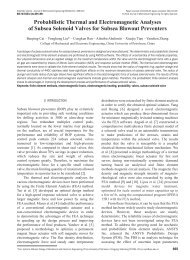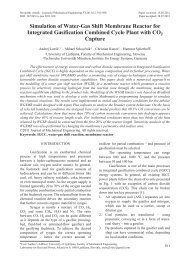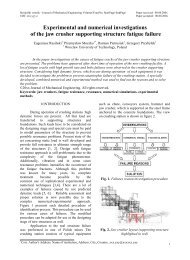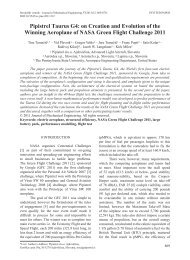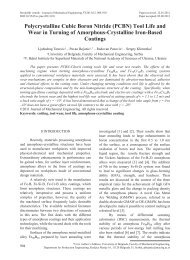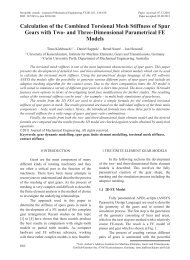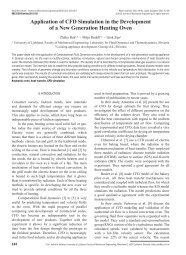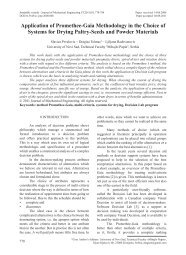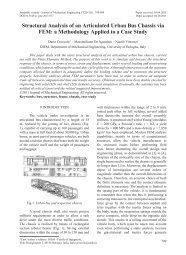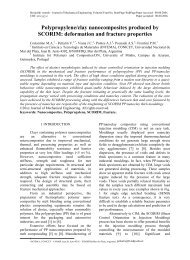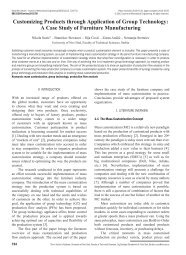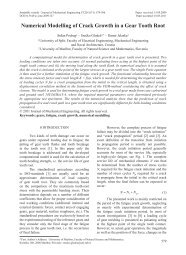Computation of Stress Intensity Factor in Functionally Graded Plates ...
Computation of Stress Intensity Factor in Functionally Graded Plates ...
Computation of Stress Intensity Factor in Functionally Graded Plates ...
You also want an ePaper? Increase the reach of your titles
YUMPU automatically turns print PDFs into web optimized ePapers that Google loves.
Strojniški vestnik - Journal <strong>of</strong> Mechanical Eng<strong>in</strong>eer<strong>in</strong>g 57(2011)7-8, 622-632not completely path-<strong>in</strong>dependent and results wereunreliable for small <strong>in</strong>tegral doma<strong>in</strong> size.The EFG method provides an efficient androbust framework <strong>of</strong> analyz<strong>in</strong>g fracture mechanicsproblems. This method has been implementedfor fracture analysis <strong>of</strong> cracks <strong>in</strong> FGMs undermechanical load<strong>in</strong>g e.g. [11] or steady-statethermal stresses [10]. In this paper, the EFGmethod is applied <strong>in</strong> both steady-state andtransient thermal fracture <strong>of</strong> FGMs. The transientthermal load<strong>in</strong>g is imposed <strong>in</strong> the form <strong>of</strong> thermalshock.This paper is organized as follows. Section1 presents the thermoelastic govern<strong>in</strong>g equations.Section 2 provides the EFG discretization form<strong>of</strong> govern<strong>in</strong>g equations. Section 3 expla<strong>in</strong>s theuse <strong>of</strong> the equivalent doma<strong>in</strong> <strong>in</strong>tegral for thermalfracture <strong>of</strong> FGMs. Section 4 describes the modaldecomposition technique to obta<strong>in</strong> the transienttemperature field. Section 5 presents the obta<strong>in</strong>ednumerical results <strong>of</strong> thermal SIF as well asparametric analyses and the relevant aspects <strong>of</strong>the results are discussed. F<strong>in</strong>ally, <strong>in</strong> Section 6conclusions are drawn.1 GOVERNING EQUATIONSA body occupy<strong>in</strong>g a space Ω surroundedby a surface Γ under external actions, body forcesand prescribed thermal boundary conditions hasbeen considered. The govern<strong>in</strong>g equations forstatic l<strong>in</strong>ear thermoelasticity <strong>in</strong> the doma<strong>in</strong> Ω are:Fourier law:where,∇⋅ σ + b = 0, (1a)∂−∇ q + Q = c T ∂t(1b)Also, the heat flux is obta<strong>in</strong>ed based on theq=−kI∇T. (2)The constitutive equation is def<strong>in</strong>ed as:σ = C :( ε −εth ), (3)ε =∇ s u,(4a)ε th = α( T −T0 ) I .(4b)Here, the material properties are the forthorderHooke tensor C , isotropic conductivity k,expansion coefficient α, density ρ and specific heatc. The field variables are displacement u, stra<strong>in</strong>tensor ε, stress tensor σ, and thermal stra<strong>in</strong> ε th andthe imposed values are heat source Q and bodyforce b. Moreover, I is the identity second-ordertensor and ∇ s is the symmetric gradient operatoron a vector field. The boundary conditions are asfollows:T = T on Γ T , (5a)kI∇T⋅ n= q on Γ q , (5b)kI∇T⋅ n+ hT ( − T∞) = q on Γ c , (5c)u= u on Γ u , (5d)σ ⋅ n=t on Γ t , (5e)where h is the convection coefficient and n is theoutward unit vector which is normal to Γ.2 ELEMENT-FREE GALERKIN METHOD INTHERMOELASTICITYWe implement the EFG method to solvegovern<strong>in</strong>g partial differential equations (PDEs)<strong>of</strong> 2D thermoelastic problems. This methodneeds only a set <strong>of</strong> nodes to construct thediscretized model. In EFG, us<strong>in</strong>g mov<strong>in</strong>g leastsquare (MLS) approximation leads stability <strong>in</strong>function approximation and apply<strong>in</strong>g the Galerk<strong>in</strong>procedure leads to a stable and well-behavedsystem <strong>of</strong> discretized equations. Here, the EFGdiscretization <strong>in</strong> the space dimension only is usedand the Kantorovitch semi-discretization processis followed. Accord<strong>in</strong>g to the EFG method, thef<strong>in</strong>al discrete equations can be obta<strong>in</strong>ed as:( ) = +( K + K ) U = F + FthC T +thK +th th thKγ T F Fγ , (6a)γ γ , (6b)where the dot ( . ) denotes differentiation withrespect to time and:F iththijthC ij=∫ ρφφ c d Ω , (7a)ΩthT thi j∫i jΩ ∫Γc∫ ∫ ∫ ∞iK = kB B dΩ+hφφ dΓ, (7b)= Qφ dΩ+ qφ dΓ+hθ φ dΓ, (7c)Ωi iΓqΓcithF γ i = γ∫ θφi ΓΓTj, (7d)<strong>Computation</strong> <strong>of</strong> <strong>Stress</strong> <strong>Intensity</strong> <strong>Factor</strong> <strong>in</strong> <strong>Functionally</strong> <strong>Graded</strong> <strong>Plates</strong> under Thermal Shock623



